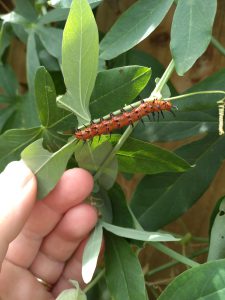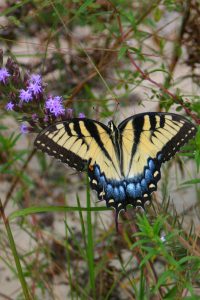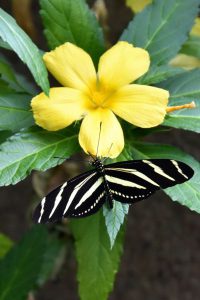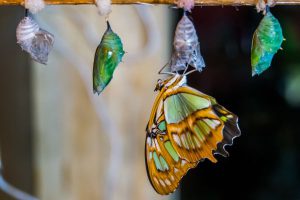 Nothing brings whimsy and fun into the garden quite like butterflies. Butterfly gardens make attractive landscape features as well as provide habitat for butterflies and other beneficial insects. Food, shelter, and water sources should be provided to make your backyard habitat a success. Shelter for a butterfly garden? Yes! Have you ever wondered where the butterflies go when we get those strong afternoon storms all summer? They tuck themselves away in tree bark crevices or between fence slats. A simple pile of logs that you have stacked up for them would be much appreciated too, especially if there are no large trees nearby.
Nothing brings whimsy and fun into the garden quite like butterflies. Butterfly gardens make attractive landscape features as well as provide habitat for butterflies and other beneficial insects. Food, shelter, and water sources should be provided to make your backyard habitat a success. Shelter for a butterfly garden? Yes! Have you ever wondered where the butterflies go when we get those strong afternoon storms all summer? They tuck themselves away in tree bark crevices or between fence slats. A simple pile of logs that you have stacked up for them would be much appreciated too, especially if there are no large trees nearby.
Water.
Butterflies can’t land on standing water, so birdbaths don’t help them much. However, you can provide minerals and nutrients with a butterfly puddler. To make one, get a shallow plant saucer or similar shaped dish and add compost. Then wet it so that you have a mud pie. It should be wet but without standing water. The butterflies will land and get needed nutrition from the compost water.
Plants.
Plant selection is the most critical part of attracting butterflies to your property. The insects will utilize different plants for different stages of their lifecycles. The adults will drink nectar from a wide variety of blooming plants but will only lay their eggs on host plants specific to their species. Once the eggs hatch, tiny caterpillars emerge onto the host plant sought out by their mother and start eating. They will eat constantly, stopping only to undergo a few molts as they grow and get ready for their next stage in the chrysalis. This means that you may attract some butterflies with flowers, but to really keep them around or to attract the specific butterflies you want to see, you should incorporate their host plants into your design.
Specific Butterflies.

 Gulf Fritillaries. Planting for a specific butterfly is exactly what my husband, Daniel, did one recent weekend. When we moved to Florida, we were gifted a beautiful non-native passionflower, Passiflora caerulea. The gulf fritillaries love it and we see at least a couple of bright orange friends flying around the vine every time we look out the kitchen window. We have been enjoying this vine and the associated butterflies so much that we wanted to try to attract some zebra longwings too.
Gulf Fritillaries. Planting for a specific butterfly is exactly what my husband, Daniel, did one recent weekend. When we moved to Florida, we were gifted a beautiful non-native passionflower, Passiflora caerulea. The gulf fritillaries love it and we see at least a couple of bright orange friends flying around the vine every time we look out the kitchen window. We have been enjoying this vine and the associated butterflies so much that we wanted to try to attract some zebra longwings too.
Zebra Longwings. Some had been seen in our yard, but they were most likely there for the firebush, which is one of their favorite nectar plants. So, when a local nursery posted on social media that they had received a shipment of natives, Daniel went right over and picked up two passionflower species, P. incarnata and P. suberosa, the purple passionflower and corkystem passionflower, both larval hosts plants for the zebra longwing. While we haven’t had a zebra longwing yet, not two hours after planting, the gulf fritillaries had already discovered the new additions to the yard.
Tiger Swallowtail. If we had more room and lived near a wooded area or backed up to a preserve, we might be able to plant host plants for the tiger swallowtail, which lays eggs on white ash, tulip poplar, or wild cherry trees. Even In a smaller yard, there might be room for a sweet bay magnolia (Magnolia virginiana). This tree is beautiful all by itself with lemon-scented white flowers and foliage with silver undersides that show in the breeze. The tiger swallowtails will use it as a host plant too.
Vertical Layering
One of the first premises of gardening for wildlife is that you should use vertical layering. Vertical layering just means that you design your landscape for different heights and layers of plants. You would have a tree layer, a shrub layer, maybe a layer of perennials and a layer of groundcovers. Different butterfly species can use plants that fit in all these layers.
Tree Layer option. The common yaupon holly is a host plant for the Henry’s elfin. This little brown butterfly may not be the queen of the garden, but still adds to the diversity of your yard.
Perennial. For the perennial layer, everyone knows that milkweed is the host for monarchs. But, did you know that plumbago, which is readily available at any garden center, is the host for the cassius blue, a small but beautiful insect?
Ground Cover Layer. In the shortest plant layers, you can introduce the native twinflower (Dyschoriste oblongifolia), which only gets a foot tall and has light purple flowers, borne in pairs. Or, how about turkey tangle fog fruit (Phyla nodiflora), a tiny groundcover of a plant that is most notably used as a turf alternative. Both groundcovers host the buckeye, which is a medium sized butterfly with brown, orange, and cream wings with a distinctive eye spot pattern.
To lure a variety of butterflies to your house, you should absolutely plant nectar plants such as
But don’t forget about the needs of their caterpillars. Add in host plants for maximum butterfly encounters in the garden.
—
This article is written by Tonya Ashworth, UF /IFAS Extension Duval County and first appeared in the Florida Times Union weekend edition at the beginning of June 2023.
 0
0




